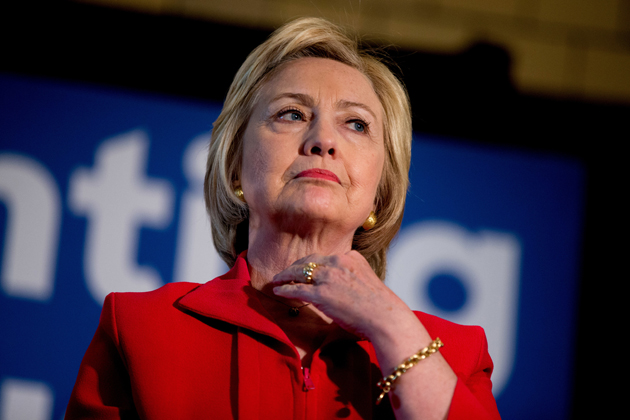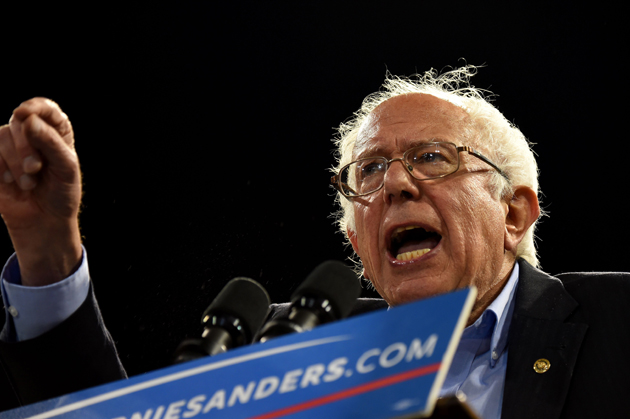
If Democrats agree on one thing, it is on the urgency of defeating Donald Trump this November. Now, as the primary season is nearing its end and Bernie Sanders’s chances of winning a majority of pledged delegates are increasingly remote, the Sanders campaign has put forward a provocative argument: If Democrats truly wish to avoid a Trump presidency, they should nominate him rather than Hillary Clinton.
There is an obvious philosophical problem: The candidate calling for a political revolution is now looking to unelected super delegates to overturn the will of the people, who have given Hillary Clinton a clear majority of both pledged delegates and the popular vote. Yet the question remains: Is Sanders correct that he is more likely than Hillary Clinton to keep Donald Trump out of the White House? At stake in this debate is not just the choice between Sanders and Clinton, but competing visions of the future of the Democratic Party.
The conventional wisdom among the commentariat — often delivered with no small amount of condescension — is that Sanders’s claim is manifestly false: his admittedly better performance in the polls, they argue, would rapidly disintegrate in the face of the inevitable assault from the Republican attack machine. William Saletan expressed the prevailing view of the punditocracy in Slate, writing that “if you were designing the perfect target for Republicans ... you’d create Bernie Sanders,” adding that the Republicans’ “only hope is a fresh piece of meat, an alternative Democratic nominee who looks clean to liberals, but is loaded with unexploited vulnerabilities and is easy to caricature as a wild-eyed socialist.” Other articles making essentially the same argument, though not always as colorfully, have appeared in Mother Jones, the Washington Post , Vox(twice), Bloomberg News, CBS/New York Times (both Paul Krugman and Charles Blow), New York, and Slate(Michelle Goldberg).
This is a serious argument and the stakes are high, for a Trump presidency would mean right-wing appointments to the Supreme Court, a drastic decline in America’s international standing, and worst of all, the corrosive legitimation of xenophobia and racism emanating from the nation’s highest office. But like other arguments, it should be carefully scrutinized and not taken for granted. And, where possible, it should be subjected to relevant empirical evidence.
That Sanders has not been the object of the kind of brutal negative attacks that have been leveled against Hillary Clinton for a quarter of a century is not in dispute. Nor is there any doubt that if Sanders were to somehow defy the odds and win the nomination, the Republican attack machine would be unleashed against him and the attacks would be ferocious. The broad contours of such attacks are easy to imagine: Sanders is a socialist, he is un-American, he has a fondness for repressive Communist regimes, and he is a “wild-eyed” radical with weird views who would tax and spend America — and American families — into bankruptcy.
The logical starting point for an assessment of the claim that Sanders’s lead over Clinton in presidential polls would evaporate once he was subjected to the full force of the Republican attack machine is with the much-maligned polls themselves. Right now the poll averages reported by both Real Clear Politics and the Huffington Post show Sanders with an average 11 percent lead over Trump, and Clinton ahead of Trump by a much narrower margin of 3 percent. The four latest polls that compare Sanders and Clinton all show Sanders ahead with margins of 12, 13, 13, and 4 percent.1 Clinton, in contrast, is ahead by 3, 2, and 6 points in three of the four polls and behind Trump by 3 points in the latest of the four; together these four polls produce an average Sanders lead of 10.5 points and a Clinton lead of 2 points. Translated into statistical terms, then, the specific claim of Sanders skeptics is that the Republican attack machine, once unleashed, would eradicate Sanders’ advantage of roughly 8 points over Clinton.
The results of the most recent of the four polls, this one taken between May 14 and 17, show Clinton to be highly vulnerable. While she trails Trump among independents 46-38, Sanders is ahead 46-30; interestingly, Sanders does every bit as well as Clinton even among self-identified Democrats (Sanders 82-5, Clinton 83-6). Most surprisingly, Latinos, who are central to any Democratic strategy (and who were heavily over-sampled in the survey) are slightly more supportive of Sanders, 66-22 v. 62-23 for Clinton.
Even more worrisome for Clinton’s prospects are voters’ views of her as a person: 71 percent say she would “say anything to get elected,” 66 percent say she is not “honest and trustworthy,” and 57 percent say she lacks “strong moral values.” The latest CBS/New York Times poll shows her net favorability rating at -21 (31 v. 52), compared to a net plus for Sanders of 8 (41-33). As Henry Enten of Five Thirty Eighthas observed, Hillary Clinton’s net favorability ratings are the lowest ever recorded, except for Donald Trump, who holds the current record.

But these results, though worrisome for Clinton, do not address the question of how Sanders would fare in the aftermath of fierce Republican attacks. Sanders skeptics assume his support would crumble, but they also make a second, more hidden but equally crucial, assumption: that Hillary Clinton has been attacked for so long and so ferociously that she is immune to further impact. As William Saletan put it: “After three presidential elections, eight years in the White House, eight years in the Senate, and four as Secretary of State, she is one of the most thoroughly investigated people in American history ... [Republicans have] subpoenaed everything they can find on her, unloaded all their oppo, and she still wins.”
Saletan and other Sanders skeptics are surely correct in believing that Sanders’s poll ratings would drop in response to a sustained assault by the Republican attack machine. But it is crucial to understand that the charges leveled against him, some of them true and others fabricated, will all be viewed — as is the case with Hillary Clinton — through the lens of public perception of his character. Here Sanders is on firm ground: 68 percent of voters consider him “honest and trustworthy” and 70 percent say he has the “integrity to be president.” In a year in which voters crave authenticity, Sanders’s unwavering consistency, his record of taking principled but sometimes unpopular stands, and his exceptional financial probity are powerful assets.
Nonetheless, Sanders’s high ratings in character would not render him immune to ferocious Republican attacks. These attacks would almost certainly depress his poll numbers, but there are reasons to doubt the familiar narrative that Sanders would be decimated. Let us begin with the charge that he is a “socialist”; it is, after all, true, and Sanders has not hidden that he considers himself a democratic socialist. Three or four decades ago, this attack would surely have been fatal; the Cold War was still very much alive, and the Soviet Union was the international symbol of socialism. But the Cold War ended more than a quarter of a century ago, and now the word “socialism” often conjures up images of Denmark and Sweden — hardly the stuff of nightmares. Broad swaths of the American electorate no doubt find the idea of a “socialist” president unacceptable, but it is doubtful whether many potential members of a Democratic coalition would vote for Trump in response to this line of attack.
Sanders skeptics often point to the disastrous Dukakis campaign of 1988 and the notorious Willy Horton ads that helped sink it as an example of what the Republican attack machine can do to a liberal Democrat. But as Princeton historian Matt Karp has pointed out, this is a profoundly flawed analogy, for Dukakis was a stiff technocrat who, he wryly notes, “won the Democratic primary not by packing arenas with passionate supporters, but chiefly by having more impulse control than Gary Hart and being whiter than Jesse Jackson.” In May 1988, only 52 percent of voters knew Dukakis well enough to have an opinion of him, making his early lead illusory; in contrast, by New Year’s Day 2016, 85 percent of Americans had formed an opinion of Sanders.
Today’s political, demographic, and media context make it a vastly different world from 1988. Perhaps the most important difference is the rise of what political scientists call “negative partisanship“ — a sharp increase in partisanship and straight-ticket voting driven by hostility to the opposing party and reinforced by shared racial, cultural, and ideological identities. This growing polarization likely sets an upper limit on the efficacy of the Republican attack machine.
A revealing indicator of the declining effectiveness of the kind of attacks that worked so well in the past was the fate of Obama in the election of 2008. In February of that year, Clinton pollster and campaign strategist Mark Penn dismissed Obama’s strong performance in early presidential polls, arguing that “Sen. Obama has never faced a credible Republican opponent or the Republican attack machine, so voters are taking a chance that his current poll numbers will hold up after the Republicans get going.” Obama, after all, was an African-American with the middle name Hussein, and he had spent a good part of his childhood in a Muslim country. During the midst of the primary campaign, in what now seems a distant memory, a video suddenly appeared showing Jeremiah Wright, the pastor of Obama’s church, shouting “God damn America!” The attacks that followed no doubt damaged Obama with Republicans, but failed to undermine his appeal to a majority of voters. Reviewing this history, Matt Karp asks a pointed question to those who believe Sanders could not survive Republican attacks: “Why does anybody believe that red-baiting will succeed where racist innuendo failed?”
The rise of negative partisanship also gives Clinton a degree of insulation from Republican attacks, as does the public’s long familiarity with many of the likely lines of attack. But it would be a serious mistake to assume that Clinton’s favorability ratings could not drop even lower; according to a recent CBS/New York Times poll, since the campaign began in May 2015, her favorable/unfavorable rating has dropped from 35-36 to 31-52, and her rating for being “honest and trustworthy” plunged from 48-45 to 32-64. To say the least, this is not reassuring.

From what we have seen so far, the Trump campaign seems likely to pursue a minimum of four lines of attack on Clinton. Together, these have the potential to do significant damage:
(1) “Crooked Hillary”: This is the probably main line of attack. Though juvenile and outside the boundaries of normal campaign discourse, this rhetoric may nonetheless prove resonant, given the public’s preexisting negative perceptions of Clinton. One possible straw in the wind is a 13-minute YouTube video entitled, “Hillary lying for 13 minutes straight,” already seen by 7 million viewers. It is difficult to watch it without noting the frequent - and politically convenient - shifts in her views on various issues. 2
(2) She is the status quo candidate: As the wife of a two-term former president, the former senator from New York, the former Secretary of State, and a two-time presidential candidate, Clinton is the embodiment of the Establishment. Given widespread popular discontent, coupled with pervasive hostility towards politicians, this is a very bad year to be the living symbol of the status quo.
(3) She favors “free trade” deals that destroy American jobs: Having once called the Transpacific-Partnership the “gold standard” of trade agreements, and having supported NAFTA, Clinton’s recent conversion to trade skeptic is unlikely to be convincing and reinforces the perception that “she will say anything to get elected.” Especially in the industrial swing states stretching from Pennsylvania to Wisconsin, this could prove a major issue.
(4) She is an interventionist who will drag America into unnecessary and costly wars: In addition to her vote for the Iraq war and her support for intervention in Libya as well as a greater military role in Syria, Clinton’s generally hawkish reputation makes her vulnerable to this line of attack. With Americans tired of 15 years of military involvement in Afghanistan and the Middle East, this issue may be a good one for Trump.
It is worth noting that none of these four lines of attack would have any hope of succeeding against Sanders, though he does have his own weaknesses. Yet even if it is true that Sanders would be the stronger candidate against Trump, and that Sanders skeptics have exaggerated his vulnerability to Republican attacks while seriously underestimating the damage that such attacks can still inflict on Hillary Clinton, it does not follow that the Democratic Party should - in defiance of the express will of the people - nominate Sanders. Assuming, as now seems almost certain, that he will fail to win a majority of pledged delegates, the violation of democratic principle that nominating Sanders would entail would be too grave. But what it does mean is that the Democratic Party, which is attaching its fortunes to a historically weak candidate in Hillary Clinton, should be responsive to the aspirations of the millions Sanders supporters not only on the party platform, but on critical issues of process. The Democratic Party should, in short, make it an urgent priority to itself become more democratic; a good place to start would be open the primaries to independents, to ease registration restrictions, and to eliminate, at long last, super-delegates - the ultimate symbol of a Democratic Party Establishment unwilling to relinquish control.
But the ultimate issue beneath the debate about whether Bernie Sanders or Hillary Clinton would be more likely to defeat Donald Trump goes far beyond party platforms and party process, for it is at bottom a debate about the future of the Democratic Party. The question to be resolved is whether a candidate like Sanders - someone committed to single-payer and truly universal health care, to free tuition at public colleges, to a $15 minimum wage, to breaking up the big banks and curbing the power of Wall Street, to increasing rather than merely defending Social Security benefits, to taking drastic measures to address climate change, and above all to radically curtailing the power of money in politics - is electorally viable. Based on the historic primary season of 2016, the answer is a resounding yes.- Publish my comments...
- 0 Comments
